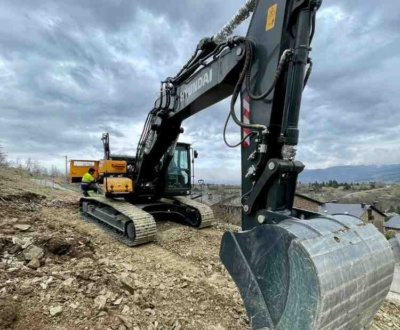Pavement plays a critical role in the functionality and longevity of roadways, providing a smooth, durable surface that supports daily vehicular traffic. The type of pavement selected for a construction project depends on various factors, including traffic volume, environmental conditions, and long-term durability requirements. The most commonly used pavement types in road construction are asphalt, concrete, and composite pavement. Each of these has unique characteristics and applications, and understanding these differences is essential when choosing the right option for a project.
Asphalt Pavement (Flexible Pavement)
Asphalt pavement, often referred to as flexible pavement, is one of the most widely used pavement types, particularly in highways, urban streets, and parking lots. It is made by mixing bitumen (a petroleum product) with aggregates like sand, gravel, and crushed stone, then heating the mixture before it is applied and compacted onto the base layer.
Advantages:
- Cost-Effective: Asphalt is generally more affordable to install compared to concrete, making it a popular choice for large-scale infrastructure projects.
- Quick Installation: Asphalt can be applied relatively quickly, minimizing disruptions to traffic and reducing construction time.
- Flexibility: Due to its ability to expand and contract with temperature changes, asphalt is less likely to crack under pressure, offering flexibility in response to environmental factors.
- Smooth Surface: Asphalt provides a smooth and quiet ride for vehicles, enhancing driving comfort and reducing road noise.
Challenges:
- Maintenance: While durable, asphalt requires periodic resurfacing and maintenance, especially in high-traffic areas or regions with extreme weather conditions.
- Temperature Sensitivity: Asphalt can soften in high heat, leading to deformation, while freezing temperatures can cause cracking in colder climates.
Concrete Pavement (Rigid Pavement)
Concrete pavement, or rigid pavement, is composed of a mixture of cement, water, and aggregates, which undergo a chemical reaction (hydration) to harden and form a solid surface. Concrete pavements are commonly used in high-traffic areas, such as highways, bridges, and airport runways, where long-term durability is crucial.
Advantages:
- Exceptional Durability: Concrete is known for its strength and long lifespan, with minimal maintenance required over time. It can withstand heavy loads, harsh weather, and chemical exposure.
- High Load-Bearing Capacity: Concrete is ideal for areas subject to heavy truck traffic or significant industrial use, offering superior structural support.
- Low Maintenance: Although initial installation costs are higher, concrete pavements typically require fewer repairs and less frequent maintenance, making them a cost-effective solution over the long term.
Challenges:
- Higher Initial Costs: The upfront cost of concrete installation is generally higher due to material costs and longer curing times.
- Extended Construction Time: Concrete requires a longer curing period compared to asphalt, leading to slower project completion and potential disruptions.
- Brittleness: Concrete’s rigidity makes it more susceptible to cracking under shifting ground conditions or heavy impacts, unlike more flexible asphalt.
Composite Pavement
Composite pavement combines the strengths of both asphalt and concrete. It typically features a concrete base layer with an asphalt surface layer, allowing the pavement to benefit from both materials’ properties. This hybrid system is commonly used in situations where both durability and flexibility are required.
Advantages:
- Enhanced Durability: The concrete base layer provides strength and support, while the asphalt surface layer ensures flexibility and smoothness.
- Cost-Effective Long-Term: The combination of materials can reduce long-term maintenance costs, especially in high-traffic environments where both strength and smoothness are important.
Challenges:
- Higher Initial Cost: The construction of composite pavements tends to be more expensive due to the need for both concrete and asphalt materials.
- Complex Construction: The installation process requires skilled labor to ensure the layers are properly bonded, adding complexity to the project
Baba Contractor and Engineer, selecting the right pavement for road construction involves a careful evaluation of several factors, including project budget, traffic volume, environmental conditions, and desired longevity. Asphalt is a cost-effective and flexible choice ideal for most roads with moderate traffic, while concrete offers unmatched durability and strength for high-load routes and industrial areas. Composite pavement provides an excellent balance of both materials, making it a smart option for projects that require both durability and a smooth surface.








